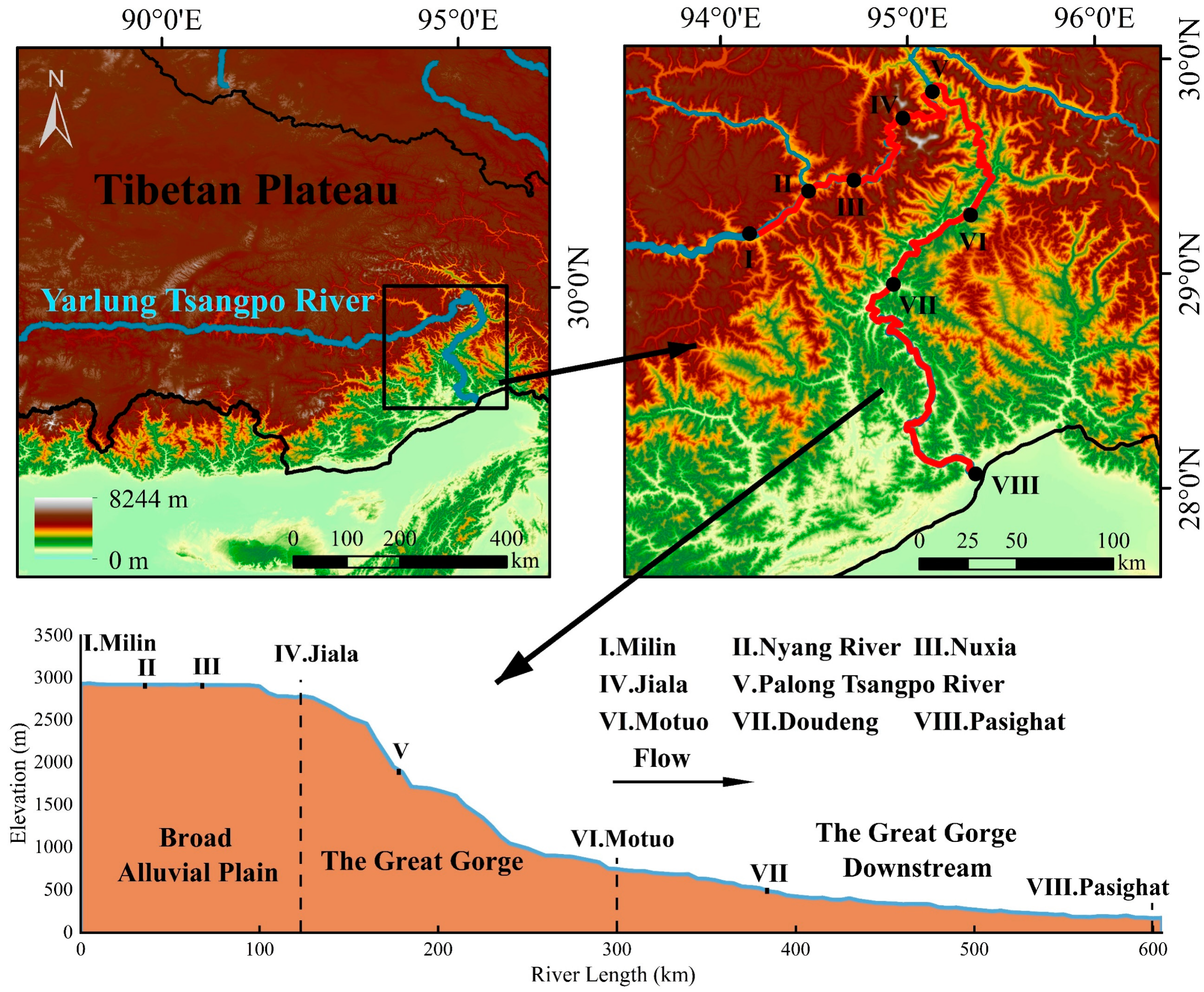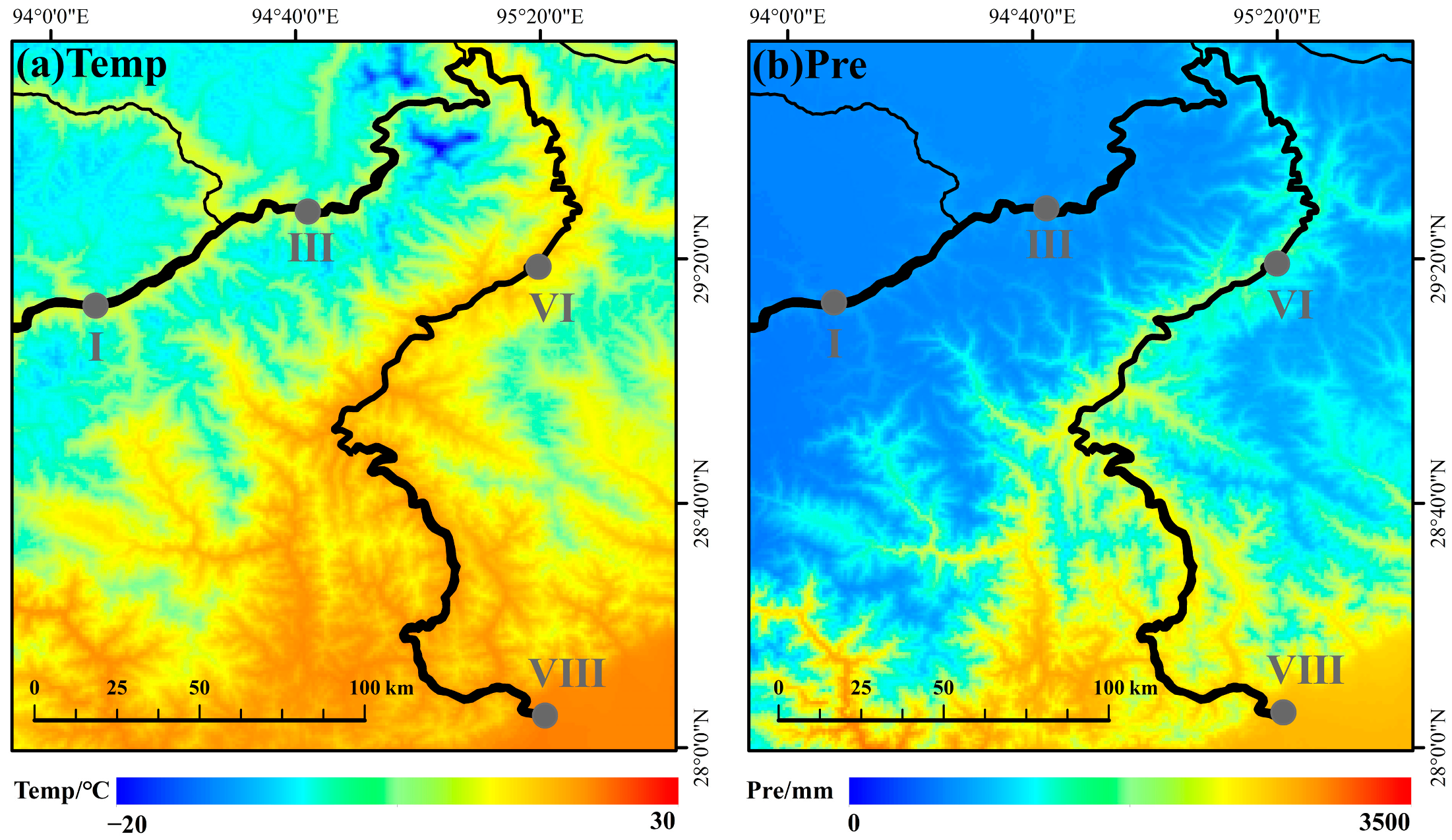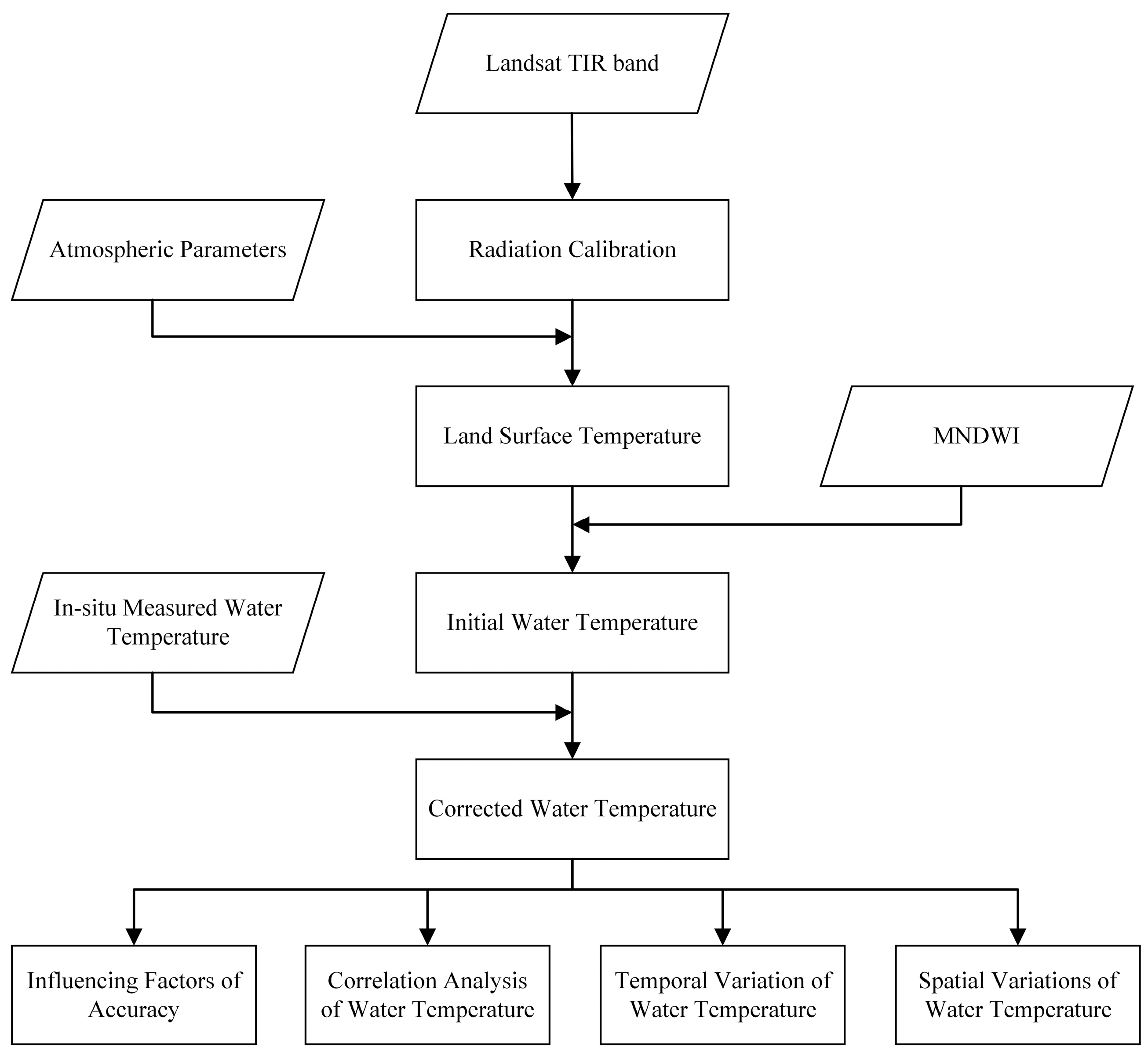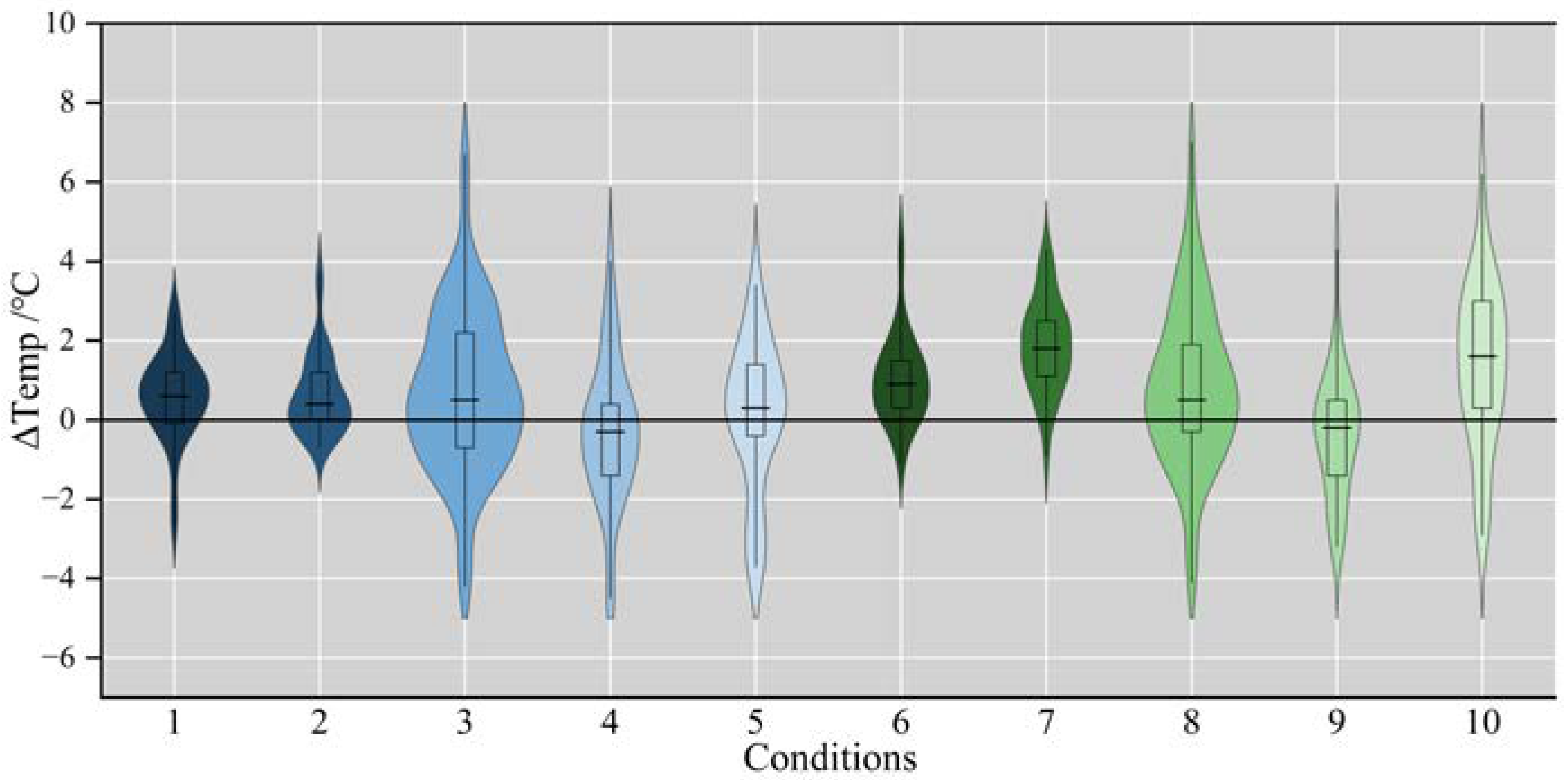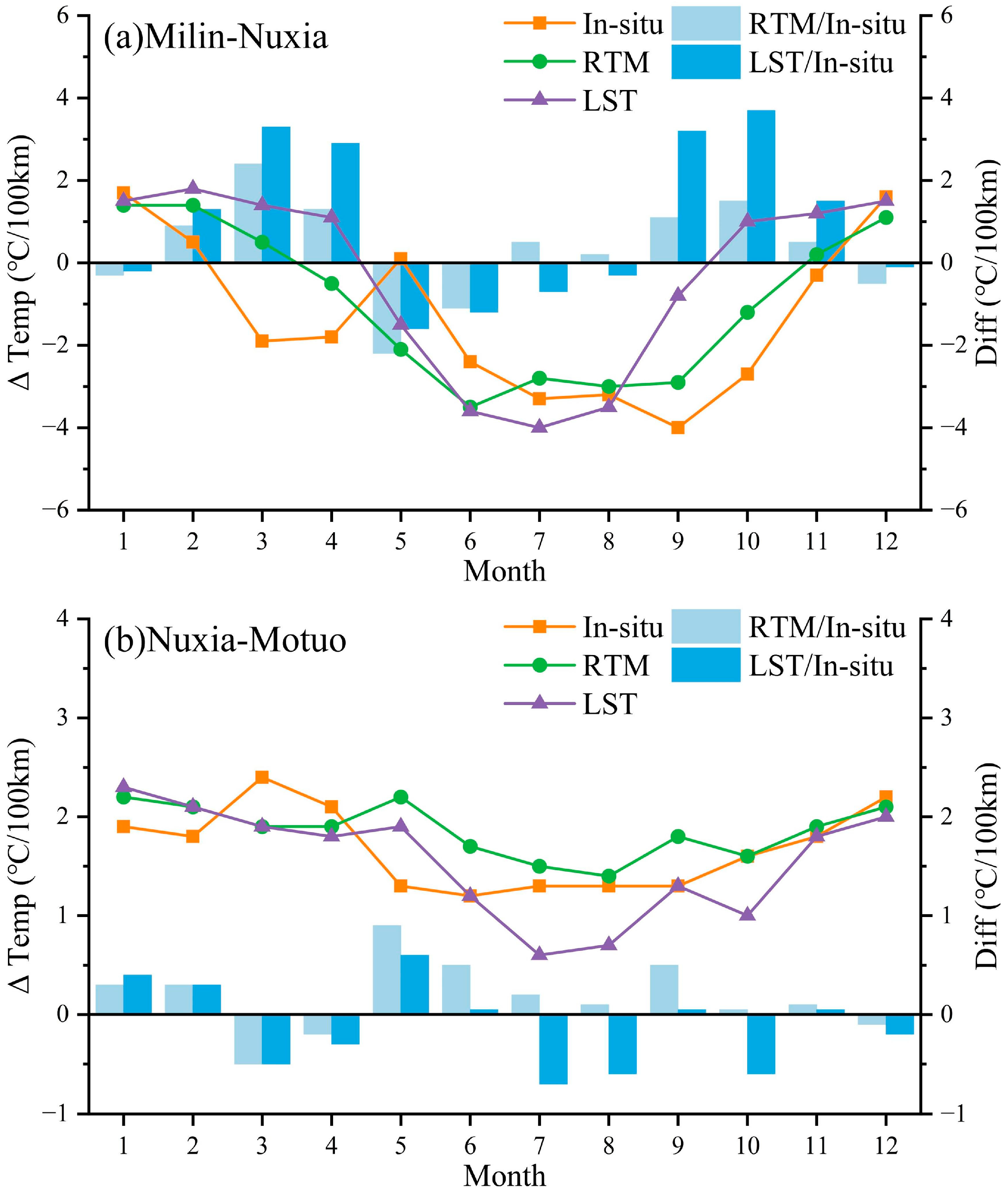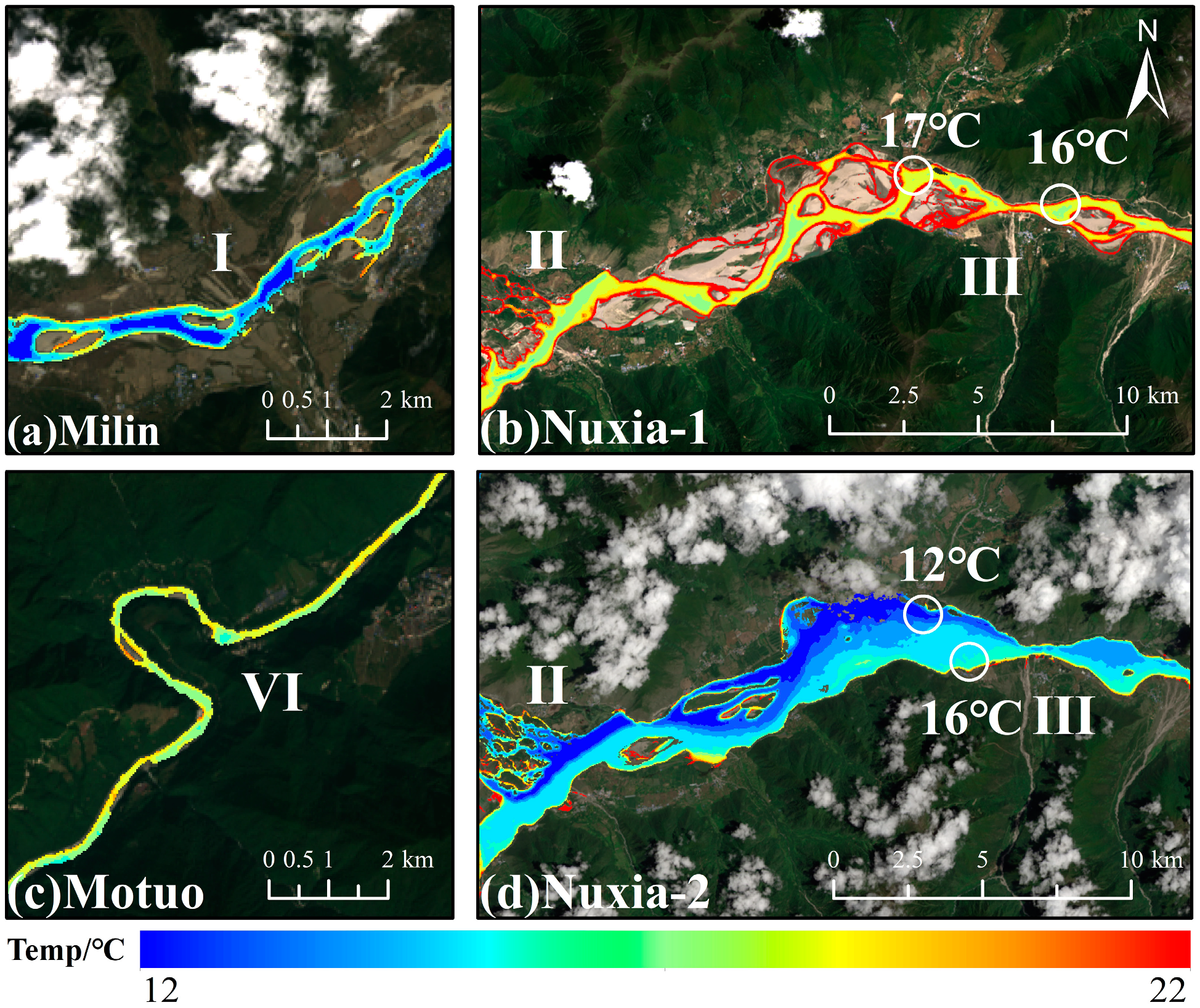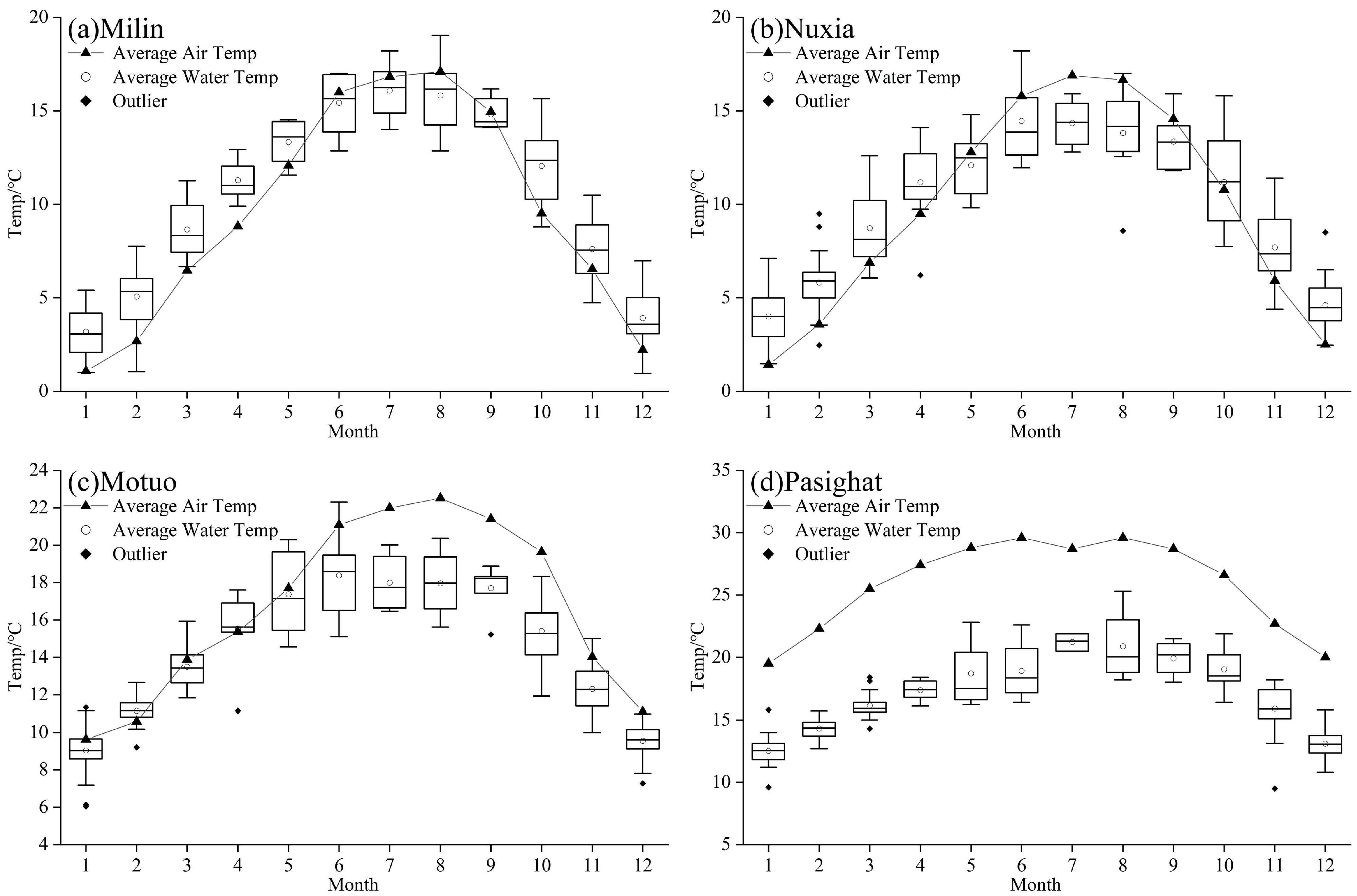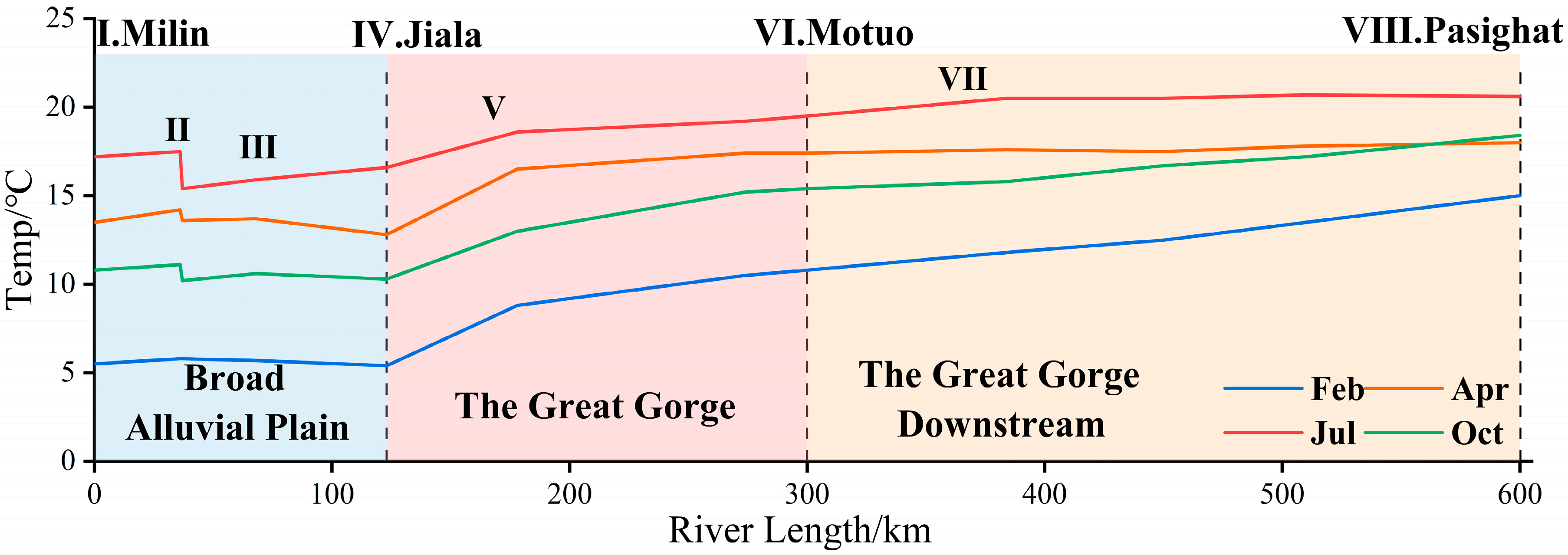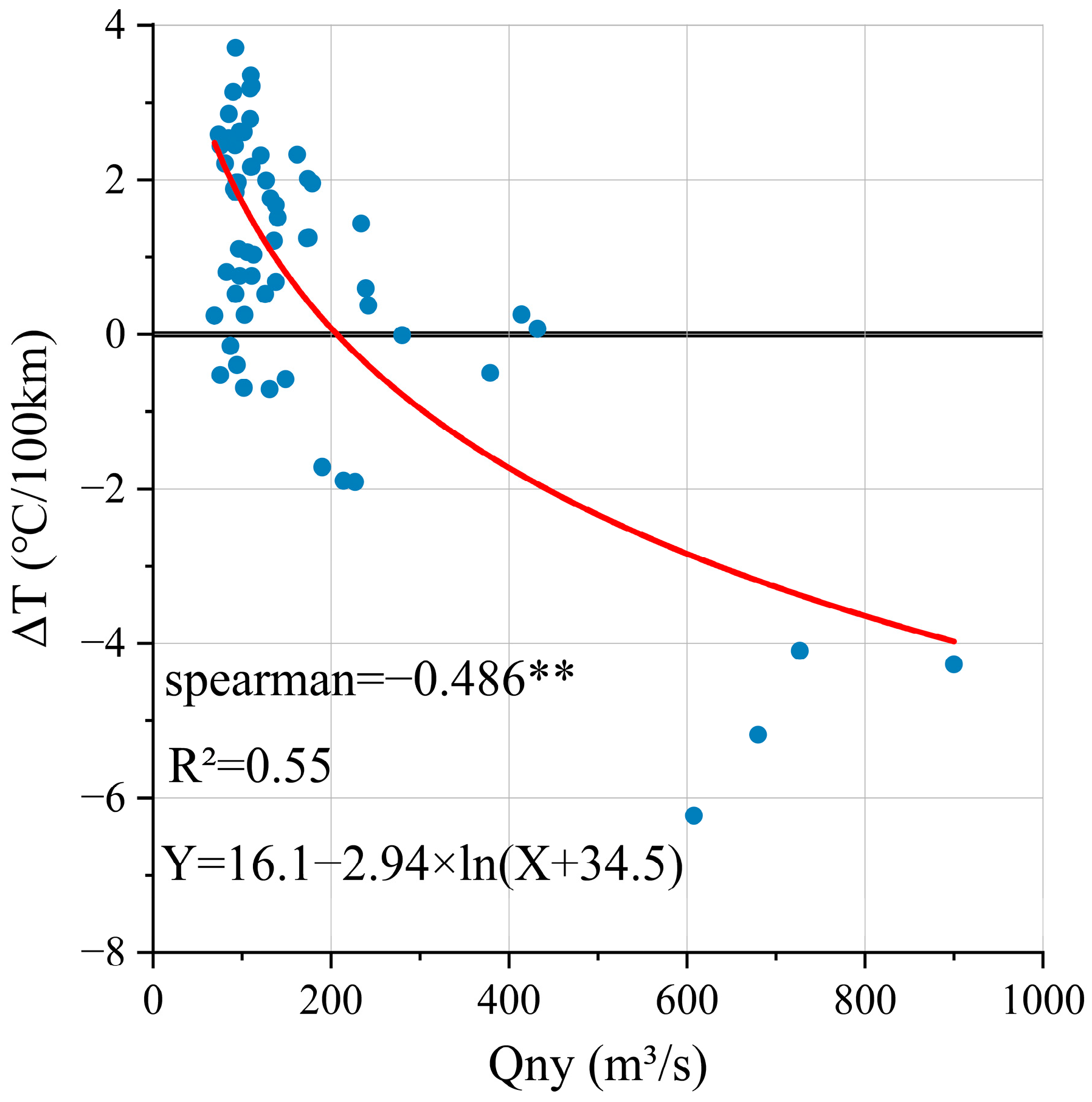1. Introduction
Water temperature, an important environmental factor in river ecosystems, regulates many physical, chemical, and biological processes in rivers [
1,
2]. Accurately understanding and monitoring the spatial and temporal patterns of water temperature is key to comprehending the health status of river ecosystems, addressing climate change, and managing water resources in a scientifically sound manner [
3]. The Tibetan Plateau is a region sensitive to global climate change, and its unique geographical and climatic conditions contribute to the spatial heterogeneity of plateau river ecosystems. Clarifying the water temperature status of a plateau river not only has profound implications for the study of its regional ecosystem status but is also highly important for understanding global climate change [
4,
5,
6]. However, plateau rivers are characterized by vast uninhabited areas due to their high elevation, rugged terrain, and harsh climatic conditions, which pose significant challenges for river monitoring. The unique hydrographical conditions and extreme climate lead to specific water temperature distributions in the river [
7,
8]. Moreover, accurately monitoring and understanding the spatial and temporal distribution patterns of water temperature in plateau rivers are crucial for maintaining the health of river ecosystems, assessing the impacts of climate change, and optimizing water resource management strategies.
Remote sensing technology, with its advantages of wide spatial coverage, high-frequency observations, and noncontact measurements, provides an effective approach for large-scale and continuous monitoring of surface water temperature [
9,
10,
11,
12,
13]. This method compensates for the limitations of in situ monitoring, such as sparse observation sites, limited data availability, and high costs. Significant progress has been made in remote sensing studies of lakes on the Tibetan Plateau. Researchers have used satellites such as AVHRR and MODIS to monitor lake surface temperature and analyze its spatiotemporal variations and influencing factors [
9,
14,
15,
16,
17,
18]. For example, Liu et al. utilized AVHRR data to construct a lake water temperature dataset covering 97 large lakes over a period of up to 35 years, providing valuable data support for water temperature studies of plateau lakes [
16]. Using MODIS data, Song et al. analyzed the spatiotemporal variations in lake water temperature in 56 large lakes over 15 years, revealing the influences of water volume, elevation, and air temperature on water temperature [
15]. Remote sensing captures long-term trends in lake surface temperature, revealing its sensitivity to climate change and deepening our understanding of climate-driven changes in plateau lakes [
9,
17,
18,
19]. In contrast, thermal monitoring of plateau rivers remains largely unexplored. The key limitations include the difficulty of accurately capturing narrow river channels with existing medium- and low-resolution satellites, the pronounced mixed-pixel effect caused by complex terrain, and the need to validate the applicability of traditional water temperature retrieval methods in riverine environments [
20,
21,
22].
Landsat data, with their finer spatial resolution (60–120 m) and long temporal coverage (since 1984), offer the potential for high-precision retrieval of river thermal conditions [
22]. The feasibility and accuracy of Landsat in studying river thermal patterns have been validated in various rivers worldwide, including the Green River, Yakima River, and Columbia River in the United States; the Rhône River in France; the Tisza River in Central Europe; and the Qingjiang, Yangtze, and Han Rivers in China [
10,
22,
23,
24,
25,
26]. However, river water temperature retrievals still face multiple challenges. Rivers are typically narrow and morphologically complex (e.g., braided channels and mid-channel bars), making water pixels susceptible to interference from land pixels [
21]. Handcock et al. noted that for rivers narrower than three pixels in Landsat 7 imagery, the retrieved water temperatures can be overestimated by 2.2–7.6 °C [
22]. Additionally, Landsat thermal infrared imagery is resampled (using cubic convolution to 30 m) before being provided to users, introducing mixed water–land pixels and further increasing uncertainties in retrieval accuracy [
27]. Accurately extracting water temperature while minimizing shoreline effects is crucial; however, research on optimal water temperature sampling locations remains limited. Shi et al. reported that selecting water pixels via square or circular regions outperformed single-grid selection methods, although these approaches may not be suitable for narrow rivers [
10]. Furthermore, Landsat-derived water temperatures tend to underestimate low temperatures and overestimate high temperatures. These errors may result from multiple interacting factors and are difficult to characterize fully, highlighting the necessity of appropriate correction methods to improve temperature retrieval accuracy [
10,
28]. Currently, various surface temperature retrieval methods have been developed, including the split-window algorithm, the single-channel algorithm, and the radiative transfer method [
29,
30,
31]. However, the application of the split-window algorithm is hindered for Landsat 7 and 8 because of the presence of only a single thermal infrared band and stray light issues, respectively [
32,
33]. The single-channel algorithm, particularly the Qin algorithm and JM&S algorithm, is among the most representative methods [
34,
35]. However, it is highly sensitive to water vapor inputs, and when atmospheric water vapor exceeds 3 g/cm
2, the retrieval accuracy decreases significantly, with errors exceeding 3K [
36,
37]. In the complex climatic conditions of the Tibetan Plateau, its retrieval accuracy may be suboptimal. In contrast, the radiative transfer method, which incorporates atmospheric parameters to correct radiative transfer processes, has demonstrated relatively high accuracy and stability in river water temperature studies, as shown in numerous studies [
28,
38,
39].
As one of the most representative plateau rivers, the Yarlung Tsangpo River serves as a reference area for studying ecosystem changes and vulnerabilities in response to climate change [
40]. The water temperature in its lower reaches varies in response to environmental changes, yet the harsh geographical conditions hinder the acquisition of fundamental data, posing challenges for in-depth water temperature research. This study focuses on the lower reaches of the Yarlung Tsangpo River: (1) constructing a remote sensing interpretation model for plateau river water temperature based on Landsat 7 ETM+ and Landsat 8 TIRS satellites, incorporating Landsat surface temperature products for simultaneous analysis to assess the feasibility and potential of using Landsat data to obtain precise water temperature measurements for narrow plateau rivers; (2) analyzing and evaluating the impact of river width, hydrology, geomorphology, and water temperature sampling locations on the accuracy of temperature inversion; and (3) investigating the correlation between river water temperature and hydrological and climatic factors, identifying the spatiotemporal variation patterns of water temperature in the lower reaches of the Yarlung Tsangpo River, and analyzing the influence of plateau topography, climate, and runoff supply on the spatial distribution of water temperature. Therefore, this study not only fills the research gap in the thermal dynamics of plateau rivers but also provides novel technical approaches and spatial data support for studying heat transfer processes in plateau river ecosystems.
4. Results
4.1. Analysis of Factors Affecting Inversion Accuracy
The studied river section has a high water vapor content and significant local climate variability, which affects the accuracy of the water surface temperature inversion. The Great Gorge is a passage for warm and humid air currents from the Indian Ocean to the Tibetan Plateau. In summer, high water vapor content, heavy rainfall, and severe cloud interference not only reduce data availability but also increase the difficulty of atmospheric correction. The RTM with the atmospheric correction parameters of Atmcorr has high accuracy in water temperature inversion, but Atmcorr represents the atmospheric state of the whole region with only one data point. To address the variability in atmospheric conditions across the entire watershed, in this study, the river was divided into a plateau area and a Grand Canyon area for the acquisition of atmospheric parameters, which helped reduce the impact of atmospheric changes on the water temperature inversion. However, differing atmospheric states may still interfere with the accuracy of temperature interpretation.
The temporal and spatial discrepancies in the inverted water temperature data compared with the measured water temperature data led to a higher inversion temperature, with some extreme high-temperature outliers present. The study area experiences significant daily temperature variations; for example, the average diurnal temperature range in Milin is 12 °C. The satellite’s overpass time is approximately 12 noon local time, whereas the measured water temperature is collected at approximately 8 a.m. local time. This discrepancy between the satellite overpass time and the water temperature measurement time partially explains why most inversion values are higher than the measured values. Moreover, the measurements from the thermal infrared radiometer represent the “skin temperature” of the water surface at approximately 10~20 µm, whereas the measured water temperature is typically taken at a depth of 0.5 m. Factors such as strong solar radiation can create differences in temperature at various layers between the surface water temperature and the water body temperature [
68]. The use of regression correction can partially reduce errors caused by temporal discrepancies and the “skin effect” [
69]. However, the errors in water temperature arise from multiple factors, and regression correction cannot completely eliminate them.
The river topography and geomorphology, tributary confluence and riverbanks all interfere with the accuracy of the river water temperature inversion, resulting in lower accuracy at the Nuxia and Motuo sites than at the Milin site. The Milin section has a suitable river width of approximately 300–450 m, with no large tributaries converging in the interval and a uniform mixing of water bodies (
Figure 7a). In contrast, Nuxia is located in the broad alluvial plain section, where the maximum river width can reach 3300 m. However, the morphology of the braided channel is complex, with land and water areas interspersed, leading to higher temperatures in wide shallow areas than in deep pools (
Figure 7b). The meltwater from the Nyang River tributary results in lateral temperature unevenness, with low-temperature water not fully mixing with the river water as it approaches Nuxia, causing the water temperature to be lower on the left and higher on the right, with a lateral temperature difference of up to 2 °C (
Figure 7d). The spatial unevenness of water temperature is influenced by tributary inflows and braided topography, and discrepancies between reading locations and measurement locations contribute to larger inversion result errors at Nuxia. The Motuo section of the river is narrow and meandering, with an average river width of approximately 200 m. For a river with only 1–3 water pixels, the mixing of water and land significantly increases the temperature error and uncertainty in the images [
22]. Owing to the narrow river channel in Motuo, the water pixels are affected by the riverbanks, resulting in lower accuracy, with an RMSE of 1.62~2.49 °C and a postcorrection error reduction of 1.6~26.1% (
Figure 7c). Linear regression shows better correction effects for Milin, with secondary effectiveness for Nuxia and Motuo, confirming the differences in error sources at the three sites.
Figure 8 shows the temperature differences between the left and right banks and the centerline at Nuxia. For the complex braided river channel, after the water–land mixed pixels at the riverbank edges are removed, the water temperature still exhibits lateral unevenness. The water temperatures on the left and right banks are generally higher than that at the centerline, with an average difference of 0.7 °C. To minimize the interference of topography and riverbanks on water temperature extraction, the water temperature values along the river centerline were extracted as the cross-sectional water temperature [
70].
4.2. Correlation Analysis of the Water Temperature
To investigate the influences of the plateau climate and hydrological conditions on the river water temperature, correlation analysis and multiple linear regression were conducted between the water temperature, air temperature, relative humidity, and flow.
Figure 9 presents the correlation coefficients among the variables, whereas
Table 6 lists the multiple linear regression equations and parameters. In Milin, water temperature and flow did not reach statistical significance in the multiple linear regression (
p > 0.05), so only air temperature and relative humidity were included in the regression analysis for this site.
The results indicate that water temperature variations in the study area are jointly driven by climatic and hydrological factors, resulting in significant spatial heterogeneity. Air temperature is the dominant factor influencing water temperature variations in the study area. Correlation analysis revealed a strong positive relationship between air temperature and water temperature, with correlation coefficients exceeding 0.9 at all three sites. The multiple regression model further confirmed the dominant role of air temperature, with standardized coefficients (β) of 0.947 (Milin), 0.829 (Nuxia), and 0.786 (Motuo), all of which were statistically significant (p < 0.01). Relative humidity had a positive effect on the regression model, with β values of 0.203 (Milin), 0.099 (Nuxia), and 0.135 (Motuo), which were statistically significant (p < 0.05). However, correlation analysis revealed that relative humidity was not significantly correlated with water temperature in Motuo. This discrepancy may be attributed to the distinct climatic conditions in the study area. The upper reach is located in a temperate plateau climate zone, where high altitudes result in thinner air and relatively low humidity (monthly average: 40–80%). Strong evapotranspiration leads to significant heat loss from the water body, making relative humidity an important factor influencing river water temperature. In contrast, the lower Motuo reach lies in a tropical humid climate zone with abundant precipitation and consistently high annual relative humidity (>80%). Weaker evapotranspiration reduces the direct impact of relative humidity on water temperature. The regression analysis, which comprehensively considers multiple interacting factors, suggested that relative humidity may influence water temperature indirectly by affecting precipitation and, consequently, flow.
The effect of flow exhibited significant regional differences. Correlation analysis revealed a significant positive relationship between flow and water temperature at all three sites (
p < 0.01). In the regression analysis, the influence of flow on the water temperature varied spatially. In Milin, flow was not statistically significant. In Nuxia, flow was significantly negatively correlated with water temperature (β = −0.161,
p < 0.01), whereas in Motuo, a significant positive correlation was observed (β = 0.135,
p < 0.05). This may be related to the sources of runoff in the basin. In the upper reaches, glacial meltwater contributes a large proportion of runoff, and variations in different water sources directly influence water temperature. In Milin, a mix of local meltwater and precipitation may explain the lack of statistical significance. In Nuxia, a major tributary, the Nyang River, joins the mainstem. During the flood season, the influx of glacial meltwater lowers the water temperature (
Figure 6a), resulting in a negative correlation between flow and water temperature. In contrast, the Motuo reach serves as a conduit for warm, humid air masses from the Indian Ocean, with substantial precipitation contributions. High air temperatures reduce the relative proportion of glacial meltwater input, leading to overall significant regression analysis, which, by accounting for all relevant factors, more accurately captures the effect of flow on water temperature, highlighting both the commonalities and regional differences in environmental influences on water temperature in the study area and the positive correlation between flow and water temperature.
4.3. Annual Variation
Four representative sites, Milin, Nuxia, Motuo, and Pasighat, were selected for the analysis of annual water temperature variation. Overall, the water temperature in the lower reaches is greater than that in the upper reaches, and the annual variation in the water temperature is greater in the downstream reaches than in the upstream reaches (
Figure 10). The annual fluctuations in water temperature decrease from the upstream to downstream sites, measuring 12.9 °C, 10.5 °C, 9.3 °C, and 8.7 °C at Milin, Nuxia, Motuo, and Pasighat, respectively. Additionally, the monthly variation in water temperature shows a more stable pattern downstream, especially during the spring and winter months from October to March, where the average interquartile range for Pasighat is 1.1 °C, and for Milin, it is 2.1 °C. This stability is attributed to the fact that the lower reaches fall within a subtropical climatic zone, where temperatures are generally higher throughout the year, and there are no significant tributaries entering the area, resulting in smaller and more stable fluctuations in downstream water temperature. The lowest water temperatures at the four sites occurred in January, at 3.1 °C, 4.0 °C, 9.0 °C, and 12.5 °C, with an average increase of 1.6 °C/100 km along the river. The highest water temperatures are recorded from June to August, at 15.8 °C, 14.5 °C, 18.4 °C, and 21.2 °C, with an average increase of 0.9 °C/100 km along the river. The highest temperature in Milin is reached in July, whereas Nuxia and Motuo experienced increased contributions of glacial meltwater during the high-temperature period in July because of the inflow of the tributaries Nyang River and Palong Tsangpo River, with peak temperatures occurring in June.
There are significant differences in the relationships between the water temperature and air temperature between the upstream and downstream regions of the studied river. In the upper reaches, the water temperatures at Milin and Nuxia are lower than the air temperatures only during the summer when snowmelt occurs. In other seasons, the water temperatures are higher than the air temperatures. The annual air temperature is 9.6 °C, which is 0.8 °C higher than the water temperature. This may be related to the strong solar radiation in the region and the low heat retention capacity of the thin highland air. In the downstream gorge section, the altitude decreases rapidly, causing air temperatures to rise quickly with decreasing elevation, while the rate of increase in water temperature is significantly lower than that of air temperature, particularly during the summer and autumn months. The annual air temperature in Motuo is 17.2 °C, which is 2.5 °C higher than the annual water temperature, and from June to October, the air temperature is 3.7 °C higher than the water temperature. Downstream at Pasighat, a subtropical climate zone prevails, with temperatures reaching 25.8 °C, which is 8.5 °C higher than the water temperature. Compared with the rapid increase in air temperature, the rate of increase in water temperature significantly lagged.
4.4. Spatial Variation
Figure 11 shows the longitudinal variation in water temperature in the downstream section of the study river during typical months across different seasons. The water temperature increases along the 600 km river stretch. However, due to influences from climate, elevation differences, and tributary inflows, the water temperature exhibits segmented characteristics in variation.
In the broad alluvial plain section (from Milin to Jiala), the river is approximately 400 m wide, and the flow is gentle, with most segments having slopes of less than 1‰. The water temperature remains higher than the air temperature throughout the year. The water temperature in this segment exhibited an overall temperature decrease, with an average rate of temperature change of −0.3 °C/100 km, varying between −0.8 and 0.1 °C/100 km. The tributary Nyang River accounts for approximately 25% of the main river’s flow, and its inflow significantly affects the water temperature of the main river. For example, in July, the water temperature of the studied river section gradually increased before the confluence and then sharply decreased by approximately 3 °C at the Nyang River junction. As the water mixes, the water temperature gradually stabilizes, resulting in a decrease of approximately 1 °C compared with the preconfluence temperature at Jiala (
Figure 11). During the dry season, the inflow from the Nyang River has little effect on the water temperature of the main river, which results in relatively stable water temperature changes in this section.
Figure 12 shows the correlation between the flow rate of the Nyang River and the warming rate from Milin to Nuxia. The results indicate a significant moderate negative correlation (Spearman’s rho = −0.486,
p < 0.01). The sudden decrease in water temperature at the Nyang River confluence reflects the significant cooling effect of glacial meltwater on the water temperature of the downstream section of the study river, which is an important factor affecting the river water temperature in this study.
In the Great Gorge section (from Jiala to Motuo), the river is narrow, with a width of 60 to 180 m and a significant vertical drop (approximately 2300 m), resulting in an average slope of up to 20‰. The water temperature steadily and rapidly increased along this 175 km stretch, rising by 3.9 °C, with a rate of temperature change of 2.2 °C/100 km. This segment features larger tributaries, such as the Palong Tsangpo River, which are mainly recharged by snowmelt, which causes the rate of temperature change during the flood season to be slightly lower than that during the dry season (
Figure 13). The summer temperature change rate was 1.5 °C/100 km, whereas the winter temperature change rate reached 3.0 °C/100 km (
Table 7). In the Great Gorge, the air temperature is slightly higher than the water temperature, and the tributary water temperatures are relatively low. The strong increase in water temperature along this segment is due primarily to significant elevation decreases in the region, which lead to substantial energy conversion from kinetic to thermal energy. Relevant studies indicate that a 100 m drop can cause an increase in water temperature of approximately 0.16 °C, whereas a 2 km drop can result in a nearly 3 °C increase. The “drop-internal energy” conversion in this river section accounts for 90% of the water temperature increase [
71].
After flowing through Motuo and entering the Great Gorge downstream section, the slope decreases, with an average gradient of 2‰. The rate of water temperature change along this stretch is slightly lower than that in the Great Gorge stretch, with an average rate of temperature change of 0.8 °C/100 km, varying between 0.5 and 1.2 °C/100 km. The Great Gorge downstream section experiences abundant rainfall and a warm climate due to the influence of warm, moist air currents, allowing the water temperature to maintain a relatively high rate of temperature change. The rate of temperature change along the section is also greater in the dry season than in the flood season, with an average rate of temperature change of 0.5 °C/100 km in spring and summer and an average rate of temperature change of 1.1 °C/100 km in autumn and winter.
5. Discussion
Remote sensing provides an important means to obtain historical water temperature data for rivers in data-scarce plateau regions. Landsat data accurately depict the patterns of water temperature variation in the lower reaches of the studied river section under high vertical drops and unique climatic conditions, providing long-term, spatially continuous water temperature data that can serve as a supplementary dataset for data-scarce regions. Owing to the limitations imposed by the 16-day revisit cycle of the satellite and cloud cover, the number of usable images per year is relatively limited. In this study, a total of 210 Landsat images were utilized, and this large dataset was leveraged to increase the reliability of the results. To obtain continuous water temperature data for precise interannual variation studies, models such as Air2Stream and CE-QUAL-W2can be integrated to acquire continuous datasets [
10,
28,
72].
The spatial resolution of thermal infrared data is a significant factor affecting the accuracy of water temperature measurements. Since the thermal infrared bands of the Landsat satellite undergo three rounds of convolution resampling, radiative mixing can affect the selection of pure water pixels [
22,
27,
70]. The native pixel spacings of the thermal infrared bands of Landsat 7 and 8 are 60 m and 100 m, respectively, which means that this method can obtain relatively reliable results for rivers with widths greater than 180 m to 300 m. To avoid edge effects, the width of the river being inverted should comply with the three-pixel rule. When the river width exceeds three pixels, the average error is only 1.2 °C. However, for river segments that are only 1–3 pixels wide, the error can increase to 2.2 °C because of the arrangement of the pixels [
22]. In the Great Gorge and downstream sections, the river width mostly ranges from 100 to 300 m, leading to noticeable edge interference in the water temperature inversion, so Motuo has the lowest inversion accuracy among the three locations. In this study, we extracted the water temperature along the centerline of the river to represent the overall water temperature, achieving an RMSE ranging from 1.55 °C to 1.85 °C for Motuo, which still indicates good accuracy. To obtain water temperature measurements for rivers narrower than the pixel size, image thermal sharpening algorithms can be considered. This approach not only improves the accuracy of the results to some extent but also enables the inversion of surface temperatures for rivers as narrow as 120 m, which is lower than the recommended 300 m for Landsat 8 [
27,
28].
The inversion algorithm also affects the inversion accuracy, and the RTM with Atmcorr atmospheric parameters demonstrates good accuracy in the lower reaches of the studied river section, where the water vapor content is high. The precipitation bands and warm zones formed in the studied river section not only cause cloud interference and contamination of satellite imagery but also impact inversion accuracy. Owing to the occurrence of stray light issues in only one thermal infrared band, the split-window algorithm is not applicable to Landsat 7 and 8. The accuracy of single-channel algorithms significantly decreases under high-humidity conditions (w > 3 g/cm
2) [
32,
33]. The studied river section is characterized by a high-humidity environment, making the atmospheric correction method the most suitable inversion algorithm for this region. The results show that the water temperature data obtained via RTM are highly accurate and can meet the needs of studies on the spatial and temporal patterns of water temperature in the lower reaches of the studied river section. Atmcorr represents the atmospheric state of the entire region when only one dataset is used, which may introduce certain errors over large areas. Additionally, there are significant differences in meteorological conditions within the study area [
28], but dividing the region to obtain different atmospheric parameters overcomes these drawbacks and results in good accuracy.
The incorporation of additional data and the correction of data contribute to improvements in inversion accuracy to some extent. For example, using an improved single-channel algorithm that incorporates Ta and w can effectively increase the accuracy of temperature inversion, resulting in smaller errors than a single-channel algorithm based only on w [
33]. Utilizing machine learning algorithms based on land cover, topography, and satellite surface temperature allows for the assessment of monthly average water temperatures in rivers ranging from 300–1000 m wide, with an overall median RMSE of approximately 1.5 °C and a Bias of 0% [
73]. Combining measured water temperatures with thermal infrared images can improve the accuracy of water temperature inversions [
74], and simple corrections based on existing field observations can enhance the consistency between “skin temperature” and water body temperature [
69]. Even though the water surface temperature derived from Landsat data generally underestimates low temperatures and overestimates high temperatures, the correction of measured data can improve the accuracy of the results [
10]. The results of this study are consistent with those of other studies, indicating that while ideal improvements may not be achieved in all cases, the incorporation of measured data effectively enhances the inversion accuracy.
Landsat satellite data provide valuable information for studying the thermal state of plateau rivers; however, this study still has certain limitations. First, the relatively low temporal resolution of satellite sensors and cloud interference, particularly the significant loss of valid imagery during the warm season, prevented this study from fully analyzing the interannual variations in water temperature under the interaction of climate change and hydrological processes. Second, this study utilized the Atmcorr atmospheric parameter database to obtain atmospheric data. However, the USGS has now adopted the Landsat L2 product to replace Atmcorr, and the accuracy and effectiveness of L2 atmospheric parameters for atmospheric correction require further evaluation. For water temperature correction, this study employed linear regression to eliminate systematic satellite errors. While this method is simple and effective, it also involves uncertainties. Future studies could integrate multiple environmental covariates, such as air temperature, land surface temperature, and elevation, while incorporating machine learning algorithms, such as random forests and neural networks, to increase the accuracy of thermal infrared temperature retrieval.
6. Conclusions
In this study, we utilized a total of 210 Landsat 7 and 8 satellite images from 2004–2022 and constructed a water temperature interpretation model to obtain water temperature data for the lower Yarlung Tsangpo River, aiming to analyze its spatiotemporal variation patterns. The verification results indicate that the water temperature interpretation model constructed using Landsat 7 and 8 images along with the RTM method has good accuracy and stability for the studied river section, with RMSEs ranging from 1.00 to 1.85 °C, and regression corrections reduce errors by 1.6% to 22.2%. The results of the RTM are better than those of the LST, making it more suitable for analyzing the spatiotemporal patterns of the lower Yarlung Tsangpo River water temperature under complex terrain and meteorological conditions. The correlation analysis results revealed that the impacts of climate and hydrological factors on river water temperature are spatially heterogeneous, with air temperature being the most significant factor. The studied section is influenced by a high-altitude climate and significant vertical drops, resulting in greater intra-annual and intramonth variations in water temperature in the upstream areas, with a notable lag in water temperature increases relative to the air temperature along the river. From a spatial perspective, water temperature exhibits segmented and differential characteristics that are influenced by geographical features, climate, and runoff supply. The broad alluvial plain section upstream shows an overall decreasing trend in temperature due to the localized snowmelt supply, whereas the influx of large tributaries results in significant lateral differences. In the Great Gorge section, mechanical energy conversion due to large vertical drops led to rapid water temperature increases, with an average rate of temperature change of 2.2 °C/100 km. In the Great Gorge downstream section, there is a subtropical climate zone, with an annual average warming rate of 0.8 °C/100 km. In summary, the water temperature interpretation model constructed on the basis of Landsat 7 and 8 data overcomes geographical and temporal limitations, providing good accuracy for the high-altitude Yarlung Tsangpo River. This method offers a convenient and feasible means of obtaining water temperature data for data-scarce rivers, revealing the unique spatiotemporal variation patterns of water temperature in the study area and deepening the understanding of the complex habitats of plateau rivers.
